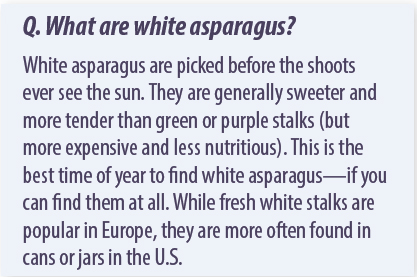Spring Veggies
While most vegetables are now available year-round, May is the month gardens and farms across the U.S. start offering up their bounty in earnest. This means lower prices and easier access to many tasty, nutritious veggies. Let’s take a look at a few!
Asparagus.
May is National Asparagus Month! The shoots of this perennial flowering plant are high in folate and a good source of vitamins A and C. Green is the most common color, but asparagus can also be purple or white.

Buying/Growing: Look for firm stalks (not floppy), with deep color and tightly closed tips. Any size is fine but bundles of similar-sized spears will cook more evenly. If you want to grow your own, keep in mind you shouldn’t harvest asparagus for the first year or two—but the plant comes back annually for 15 to 20 years!
Storing: Asparagus keeps best if you keep the tips dry and the bottom of the stems wet. Trim the bottoms and wrap them in a wet paper towel or stand them in a vase or cup with about an inch of water. Store in the refrigerator and use within three to four days.
Cooking: Asparagus are at their best (and their most nutritious) when they are steamed, roasted, or grilled. Always snap or cut off the tough bottoms. You may also want to peel the bottoms of thicker stalks with a vegetable peeler. Thinner, more delicate stalks are good tossed raw into pasta dishes, risotto, and salads.

Spring Greens.
Small, young leaves are known as “Spring” or “baby” greens. These tender little leafy bites have become popular all year round. There are seemingly endless varieties of greens—from baby romaine, spinach, and kale to young mustard greens, butter or oak leaf lettuce, chard, arugula, endive, radicchio, and mesclun. All provide nutrients like vitamins A, C, E, and K, beta-carotene, folate, iron, magnesium, potassium, calcium, and fiber. Darker colored leaves (whether green, red, or purple) are a bit more nutritious, but all are a great addition to your dietary intake.
Buying/Growing: You can buy packages of individual baby greens or choose a mixture, often marketed as “spring mix.” Choose greens that look crisp, not wilted, and do not have browned edges. You can plant seeds for your own greens in garden beds or an outdoor pot when the soil temperature reaches 45°F. You will have tender, tasty, baby greens to harvest in 20 to 30 days. (Take just the outside leaves, and the same plant will provide you with greens for weeks.)
Storing: All leafy greens are delicate and very perishable. When kept refrigerated, fresh greens should last around one week. Don’t wash greens until you’re ready to use them (it is not necessary to wash pre-washed greens).
Cooking: Spring greens are great for throwing together a quick salad or adding crunch (and nutrients) to a sandwich or wrap), but they can also be cooked. Sauté in little oil and top with a squeeze of lemon juice, a pinch of salt, and a few grinds of pepper and you’re good to go.

Cilantro.
This herb is a key ingredient in the food of many cultures. It contains the same general vitamins and minerals as other leafy green plants but is usually eaten in amounts too small for these nutrients to contribute meaningfully to one’s intake.
Buying/Growing: Look for bright green bunches with no yellow or brown leaves. Avoid limp, wilted cilantro. With good drainage, soil, and light, you can grow this herb inside or out. Cilantro grows quickly, going from seed to harvest in about three weeks.
Storing: To keep cilantro fresh in the fridge, remove any rubber bands or ties, wrap bunches in a dry paper towel, and seal them in a plastic bag or container with excess air removed. Or you can trim the bottom of the stems and stand your cilantro in a little water on your kitchen counter. Be sure to keep the leaves dry and change the water daily.
Cooking: Use chopped leaves as a garnish sprinkled on soups, stews, tacos, fish, poultry, and meat dishes. Stir them into salsa and guacamole, add them to Indian cuisine, or make a green chutney. Fresh spring vegetables like these are great choices, but so are all other fresh or frozen minimally processed veggie (and fruit!) options. Include a colorful variety at every meal— no matter what the season.

The post Spring Veggies appeared first on University Health News.

